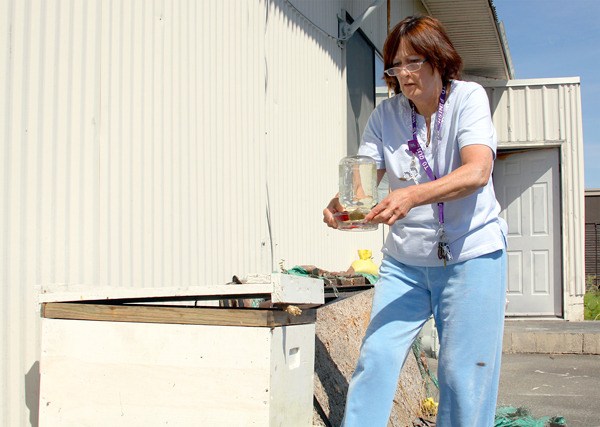When Debra Staley gets busy quilting or tending to a customer at her downtown Oak Harbor business, she sometimes forgets about an additional responsibility she’s recently taken on.
Life can become a little overwhelming when you take on an extra mouth to feed — not to mention, an additional 6,000.
“Is it empty?” Staley inquired this week from her store’s front counter about a jar containing sugar water.
“I have to go feed them.”
Honeybees have taken up residence behind Staley’s craft store after she allowed one of her quilting students, a beekeeper, to bring a man-made hive from home.
The idea seemed to make perfect sense to Staley, who’s heard about the sharp decline of the world’s honeybee population over the past decade.
She’s become more educated about bees and other pollenating insects’ critical link to plant reproduction.
Anita Anderson-Johnson, owner/broker at Island Brokers Realty and beekeeping enthusiast, suggested to Staley that a hive behind the her Quilter’s Workshop could be beneficial to the nearby ornamental, fruit and vegetable gardens at Hal Ramaley Memorial Park and the Imagine Permaculture Food Forest along Bayshore Drive.
She also thought the store was isolated enough from other businesses to not cause a problem with the public.
Honeybees were seen buzzing around both gardens this week, traveling from one colorful flower to the next.
Their range is about two miles, Anderson-Johnson said.

“That park is so beautiful,” Anderson-Johnson said. “With all of its flowers, we thought it would be a lovely place to put a new beehive above the park and of course where nobody can find it.”
Dave Anderson, building official with the City of Oak Harbor, said he wasn’t aware of any city ordinance that would prevent a business owner from having a beehive on his or her property.
“If it becomes a nuisance, they start stinging people or become aggressive, then we have to deal with them,” Anderson said.
The bees reside in a hive at the rear of the property far away from where the public should come into contact without intentionally seeking them out.
Staley and Anderson-Johnson serve as their caretakers, which includes cleaning out and refilling a jar with sugar water daily.
Staley said the buzzing bees can be intimidating but she tries not to show fear when she removes the jar from the top of the hive to refill it.
In the week since she’s had the hive, she said she’s never been stung.
“All I’m getting out of it is a little jar of honey,” Staley said with a smile, “and a lot of knowledge.”
Honeybee colonies have been disappearing at alarming rates over the past decade due to stressors that include pathogens, parasites, decreased habitat, exposure to pesticides and lack of nutritional resources.
The White House in May outlined a national strategy to expand research and education and to increase pollinator habitat.
Colony Collapse Disorder was the name given to the phenomenon in 2006 that described honeybees’ sudden and widespread disappearance. Adult worker bees were abandoning hives, leaving behind the queen and some immature bees.
Anderson-Johnson said she split one of her overflowing hives on her home property and started the new hive downtown.
She said the new residents are doing well.
She’s fascinated by honeybees and their behavior.
“A female bee will go out and find a good source of nectar,” Anderson-Johnson said. “She’ll come back and do a waggle dance in the hive to tell everybody.”
A honeybee was seen waggling at the entrance to the hive Wednesday, seemingly pleased with its new surroundings.



